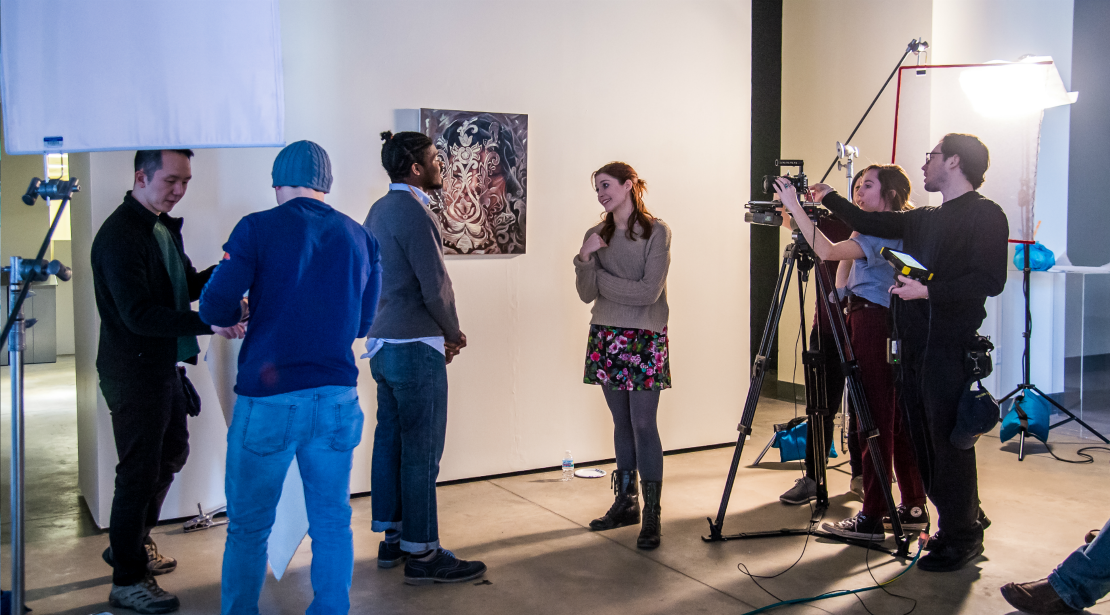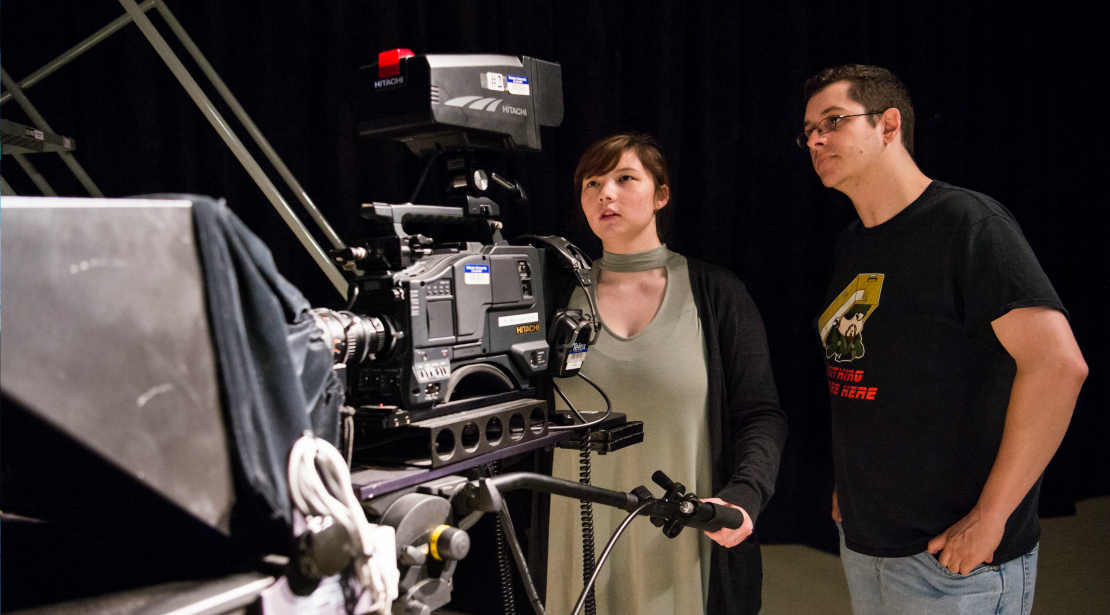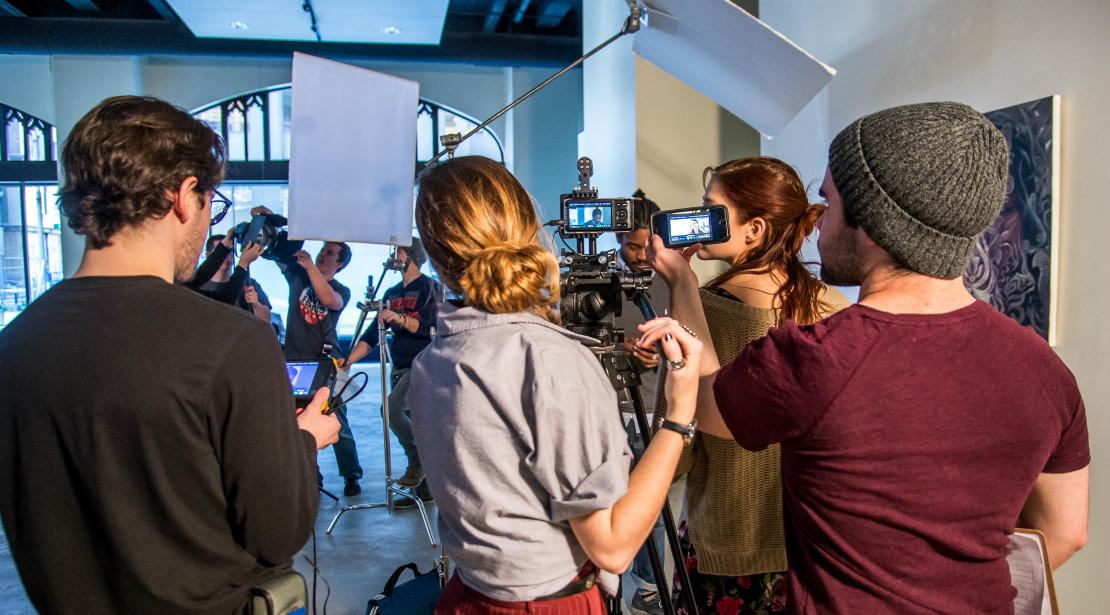Webster Named Unreal Engine Academic Partner
Webster Named Unreal Engine Academic Partner
Webster University is an Unreal Engine Academic Partner with Epic Games for its Games and Game Design and Film, Television and Video Production programs. As an official Unreal Engine Academic Partner, Webster students receive teaching materials, case studies, opportunities to connect with other academic partners and exclusive access to showcase work on professional platforms.

Navigate the Evolving Multimedia World Successfully with Our Expertise
The Department of Media Arts is a blend of traditional artistic disciplines amplified by incorporating the technological advances of the contemporary world. As a media artist, you will use emerging skill sets to thrive in the cinematic and interactive arts industries of today and communicate your vision with impact, engage audiences and stand out amongst the crowded multimedia landscape.

School of Communications

School of Communications

School of Communications
Undergraduate Majors, Minors and Certificates

“I get hands-on experience. By the end of the four years, I'll know what I'm doing enough to where I can get a job in the industry. Webster is giving me access to equipment and professors who know what they're doing.”

BA in Film, Television and Video Production, ’26
Spotlight on Emerging Technology in Media Production
Webster University's state-of-the-art virtual cinema system and newly renovated facilities housed at the School of Communications were recently featured on Channel 9 PBS's "Living St. Louis." The new facilities put Webster at the forefront of new media production methods, ensuring Webster's success into the next century of cinema creation.
Transcript
[Bright music plays]
Text on screen: Webster University’s Virtual Cinema System, Arrival of a Train at La Ciotat, Lumiere No. 653
Channel 9 PBS logo shown in corner of screen throughout video.
[Students on stage with camera and video equipment. Black and white video footage of a train station with people standing near the tracks as the train pulls in.]
Brooke Butler: There's a well-known story in the world of cinema about an early film made by the Lumiere Brothers. Because the concept of film was so new, when “Arrival of a Train at La Ciotat” was shown to audiences for the first time, it was said that people ran out of the theatre in a frenzy for fear that the train would not stop and would plow right off the screen.
[Modern-day virtual cinema classroom showing a moving subway train on one wall with a group of students and faculty watching and talking.]
Text on screen: Living
Virtual Cinema System, 127 years later, the technological advancements of filmmaking have these students captivated by a train on a screen for much more complex reasons.
Eric Rothenbuhler: This is the first virtual cinema system in the St. Louis area and it's gotta be one of very few in an educational institution anywhere in the country.
[Rothenbuhler sitting inside the Sverdrup Technology Complex.]
Voices in campus classroom: Do you guys wanna try? You can put it on the camera.
[The crew] Sure.
Butler: This virtual cinema system utilizes advanced technology to create any setting or atmosphere and calibrates it to this LED studio wall as a soundstage. Basically, it allows a video to take place in any real or imaginary location.
[Students stand in front of a virtual reality background in a classroom.]
Text on screen: Eric Rothenbuhler, Dean, Webster University of School of Communications
Rothenbuhler: You can shoot a sunrise scene inside a soundstage all day long. You can shoot a rainy day indoors. You can shoot a sunny day indoors on a rainy day. It gives you complete freedom of production. You can also shoot actors in an imagined environment.
[A virtual reality background is shown with a person-shaped place holder.]
Rothenbuhler: You can invent environments and so on.
Butler: A major production to utilize this technology was “The Mandalorian,” in which over 50% of the first season was shot with a virtual cinema system.
[Images of a Stormtrooper action figure is shown from the “Star Wars” stories. A setting inside the classroom is changed into a virtual reality scene in the science fiction movie. Large pieces of equipment and props are shown.]
Butler: And while these film and video production majors at Webster University probably won't be creating something as large scale as that, this technology is a recently added feature to the major renovations of the School of Communication's production facilities.
[Several photos of classroom preparation and technical equipment being set up. A page from the School of Communications website is shown.]
Butler: So when I was in undergrad here, this was ... I'm lost right now. I don't even know where we are. The media center was this way. So what's happening here?
[Different angles and hallways of Sverdrup are shown as Rothenbuhler gives Butler a tour.]
Rothenbuhler: So this remodeling was a complete gutting of the building. So everything but the exterior envelope was demolished and pulled out and then reconstructed so that it could be purpose-built as a communication and media production facility.
[Footage of the building when it was gutted for the new construction. Imagery of a virtual scene setting inside a classroom.]
Butler: The Sverdrup Building was built in the 1980s before Webster even had a School of Communications.
[Various images and footage of the inside of Sverdrup before it was renovated.]
Butler: As the field grew exponentially, they built a small TV studio and fashioned classrooms into editing labs, dark rooms and a media center. So now through this remodeling process, students no longer have to squeeze into makeshift studios, but have access to more intentional production spaces.
[Various images of professors and students in classrooms, sound editing studios and working on other technical equipment.]
Butler: So technology has helped in a lot of ways. It's also raised the question, everyone with a phone is a filmmaker now. Everyone can go on YouTube and learn how to program a game. How has that affected enrollment?
Rothenbuhler: I believe one of the reasons we've seen growth, everybody wants to tell visual stories, and young people have more facility with visual stories than earlier generations did. But you may not be a master storyteller yet. We all speak English. That doesn't make us all bestselling novelists.
[More technical equipment is shown in various studios with Rothenbuhler showing it all and talking to Butler.]
Rothenbuhler: So we can take those native skills and shape them into professional skills. So this is an immersive sound system. There'll be 19 speakers in here. That creates a full 360-degree spherical sound field.
Butler: So all of this, just the process for this room, there's a lot of money in this room is what I'm saying. Do you see the return on investment happening?
Rothenbuhler: Absolutely. The facilities we're providing our students now mimic, they're designed architecturally and technically to mimic the kinds of workplaces they'll be moving into after they graduate.
[More classroom shots with students creating imagery and videos for cinema.]
Butler: Having these educational settings that resemble real industry workplaces especially makes sense with instruction from faculty members who continue to work in the industry.
Text on screen: Joshua Johnson, Assistant Professor, Webster University
Joshua Johnson: I'm still, even though I'm full-time teaching here, I'm still out there working. This past summer I worked on “Hocus Pocus 2.”
Text on screen: Juraj Bohus, Associate Professor, Webster University
Juraj Bohus: So now I'm working on a film which I have 3D actors.
Butler: Joshua Johnson and Juraj Bohus are co-teaching the first class utilizing the virtual cinema system.
[More classroom examples of virtual cinema settings are shown with students and professors talking and interacting.]
Butler: And while most film and video production classes don't rely on a textbook way of teaching, this class is particularly flexible.
Text on screen: Vincent Italiano, Student of Film, Television & Video Production
[Italiano shown talking to camera.]
Vincent Italiano: It's not like other programs where you have a selected curriculum and there's a bunch of tests you have to take and materials you have to cover. This is a process where everybody is learning, including the professors. It's completely experimental.
[Footage of Italiano working in a virtual cinema classroom.]
Italiano: My goals after I graduate I think are to get with some larger production houses with LED walls and visual effects and stuff like that.
Text on screen: Joshua Johnson, Assistant Professor, Webster University
Johnson: I think that's really important for students to have a professional, their professor, to actually be there still working in projects. Because as you can see, technology changes pretty quickly.
[Bohus shown talking while facing camera.]
Bohus: Things are kind of changing to the point where in the future it'll be very interesting to see like what is what. It's pretty uncanny.
Text on screen: Living St. Louis
Butler: For Living St. Louis, I’m Brooke Butler.
Department of Media Arts Points of Distinction
Our faculty and staff includes filmmakers and video producers who have worked in all facets of production and for networks and studios including Netflix, A24, Adobe, SIGGRAPH, HBO, Sundance, Universal, Microsoft, PBS and The Discovery Channel. You'll learn practical, real-world techniques used on professional film sets and editing studios from award-winning professionals who have worked in many disciplines of production.
Our unique internship program gives you access to studios and production companies at the local, regional and national level. Our internship director in the School of Communications ensures that all students who are interested in pursuing an internship are best prepared to “get the job.” The director of the Internship Program also ensures each internship has structure and definitive learning outcomes.
We have a full-time staff member in the School of Communications who is dedicated to finding and securing internships for our students. Each year, we have an on campus Internship Expo attended by several companies and organization looking for interns. These internships may be paid or unpaid depending on the student’s arrangement with the employer.
Interactive Digital Media majors have interned at businesses and organizations around St. Louis as well in other states in countries, including Integrity Media, Momentum, 963 Collective, Websanity, FleishmanHillard, Twist, Coolfire Media, and C3 Presents (Austin, Texas).
Interactive Digital Media Majors
We strongly encourage our students to study at one of Webster’s international campuses. The tuition is the same, and because you will be studying at a Webster campus, you will not need to transfer any credits when you return. If you are a full-time student in good standing and choose to study abroad for at least eight weeks, the University will fund your plane ticket to and from any of Webster’s international campuses. Working closely with an advisor, many interactive digital media transfer students have been able to incorporate international experience during their two-year tenure at Webster.
Film, Television and Video Production Majors
You will have the opportunity to study international documentary production and film studies at our campuses in Leiden, the Netherlands; Geneva, Switzerland; and Vienna, Austria.
Animation
Webster University provides access to industry-level software and hardware, including Cintiq workstations and motion-capture technology.
Film, Television and Video Production
Our state-of-the-art equipment packages include ARRI Alexa Mini LF, Sony FS-5 and A7, Blackmagic Pocket 4K Cinema Cameras, Aputure LED, LiteMat, Pavotube, KinoFlo, ARRI Tungsten and M18 HMI Light and more. We also preserve 16mm film equipment for special topics classes.
The professionally outfitted post-production facilities let students engage in industry standard software including, but not limited to: Adobe Premiere, After Effects, Davinci Resolve, Avid, NUKE, Cinema 4D and Maya.
Department of Media Arts Special Events
The Kinematifest is a student initiative created for and by Webster University students. Its mission is to inspire and innovate Webster University students to grow as artists through motion pictures; to draw attention to rising filmmakers and animators; to give students a chance to present their work; and to encourage dialogue with the community.
The festival is an event designed to promote student work. We want to allow students and the greater community to enjoy art in an all-encompassing virtual event. With independent films and animation, professional speakers and local companies we will provide a day full of exploration and entertainment in the world of film. The three core outcomes of the festival are competitive success, inspiring creativity and creating a strong community network.
There are nine categories: Animated Shorts, Animated Clips, Comedy, Documentary, Drama, Experimental Animation, Experimental, Horror and Music Videos.
The Kooyumjian Gallery has had a home on campus since 1988 and was recently expanded and reopened in 2022 as part of extensive renovations at Sverdrup Hall. The gallery is one of the few spaces in the greater St. Louis area dedicated to showing photographic work and often displays the work of Webster University students. The Gallery plays host to the Annual Juried Student Photography Exhibition, giving students an opportunity to participate in a competitive and respected event.
Webster University hosts the Webster Film Series, a nationally recognized, year-round film exhibition program. Webster University is known for encouraging film artists to display their work within the community and this program prides itself as the most comprehensive alternative film series in the St. Louis region. The Webster Film Series offers a premiere film almost every weekend and frequently screens classic cinema on weeknights. Past visiting filmmakers include documentary filmmaker Ken Burns and writer/director John Waters.
Past visiting animation artists and historians include Floyd Norman, Rich Moore, Byron Howard, Bill Plympton, Emily Hubley, Faith Hubley, Brad Schiff, John Canemaker, Jerry Beck, Will Vinton, Ray Harryhausen, Kathy Rose, Deanna Morse, Ari Grabb, Chuck Jones, Frank Thomas and Ollie Johnston.
Past visiting game designers include Connor Brown, senior-level designer for Last of Us Part 2 and God of War.
Past visiting filmmakers include Ken Burns, Spike Lee, Jason Reitman, John Waters, Evan Adams, Adam Neil, Geena Davis, David Skal and Jin-won Han.
Connect with the School of Communications

In the News - Dec. 15 2025
December 15, 2025

In the News - November 4, 2025
November 4, 2025
Faculty and Staff Highlights: Bruce, Hoover, Martin, McMullen
October 13, 2025
Webster University faculty and staff highlights offer a roundup of recent Webster faculty and staff activity and achieve...
